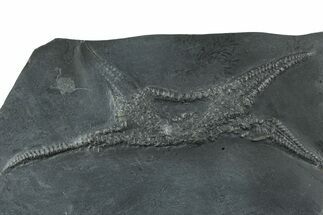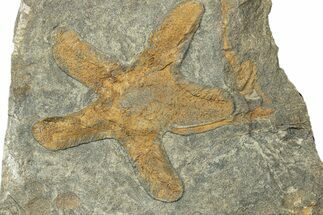This Specimen has been sold.
9.8" Fossil Blastoids w/ Brachioles, Starfish & Edrioasteroid Plate
This is a 9.8" wide plate of interesting fossils, collected from the Ridenhower Formation of Illinois. It features two Pentremites blastoid fossils with visible brachioles (feeding arms), a beautifully preserved edrioasteroid, and a starfish. The largest blastoid measures 2.1" long, the edrioasteroid is 1.4" wide, and the starfish is .6" wide. Various bryozoan fossil are scattered throughout the rock as well.
These fossils are Upper Mississipian in age or approximately 325 million years old. All of these fossils have been meticulously exposed using air abrasives under stereo microscope. There is a repaired crack through the rock.
Comes with a display stand.
These fossils are Upper Mississipian in age or approximately 325 million years old. All of these fossils have been meticulously exposed using air abrasives under stereo microscope. There is a repaired crack through the rock.
Comes with a display stand.
Blastoids are an extinct type of filter feeding, stemmed echinoderm that resembles a small hickory nut. They thrived during the Mississippian period before going extinct during the great Permian extinction. While not as diverse as their crinoid relatives, they were equally as common in rocks around the world. Blastoids were protected by a set of interlocking plates that formed the main body, or theca. In life, a typical blastoid's theca was attached to a stalk or column made up of stacked disc-shaped plates.
Edrioasteroids are an extinct class of echinoderms. Distantly related to starfish and sea urchins, they have a body laid out in a pentaradial (five-fold symmetry) pattern. They also had a water vascular system and a skeleton made of calcite plates. They were filter feeders who lived permanently attached to an object or the seafloor. Some are thought to have had short stems like crinoids, but most lived flat on whatever object they had attached to as larvae. Edrioasteroids appear in the Cambrian Period about 515 million years ago. Their diversity peaked during the Late Ordovician Period. By about 275 million years ago, during the Permian Period, edrioasteroids are extinct.
Edrioasteroids were small organisms from a few millimeters to a couple centimeters wide. They look like a tiny cushion attached to a substrate. The mouth was in the center of the theca (body) and from it, five ridges radiate out in a pentaradial pattern. These ambulacra channel food along the body to the mouth. There is little fossil evidence of how this was done, but by looking at modern echinoderms, it is likely Edrioasteroids had cilia or tube feet along the ambulacra that moved the food to the mouth. The ambulacra radiate out from the mouth in either straight lines, or curving to form a whorl. Usually they all curve in the same direction, but in a few species they curve in different directions.
Edrioasteroids were small organisms from a few millimeters to a couple centimeters wide. They look like a tiny cushion attached to a substrate. The mouth was in the center of the theca (body) and from it, five ridges radiate out in a pentaradial pattern. These ambulacra channel food along the body to the mouth. There is little fossil evidence of how this was done, but by looking at modern echinoderms, it is likely Edrioasteroids had cilia or tube feet along the ambulacra that moved the food to the mouth. The ambulacra radiate out from the mouth in either straight lines, or curving to form a whorl. Usually they all curve in the same direction, but in a few species they curve in different directions.
SPECIES
Pentremites sp., Unidentified Edrioasteroid & Unidentified Starfish
LOCATION
Illinois
FORMATION
Ridenhower Formation?
SIZE
Rock: 9.8 x 8" Rock
CATEGORY
SUB CATEGORY
ITEM
#251849
We guarantee the authenticity of all of our specimens.
 Reviews
Reviews















